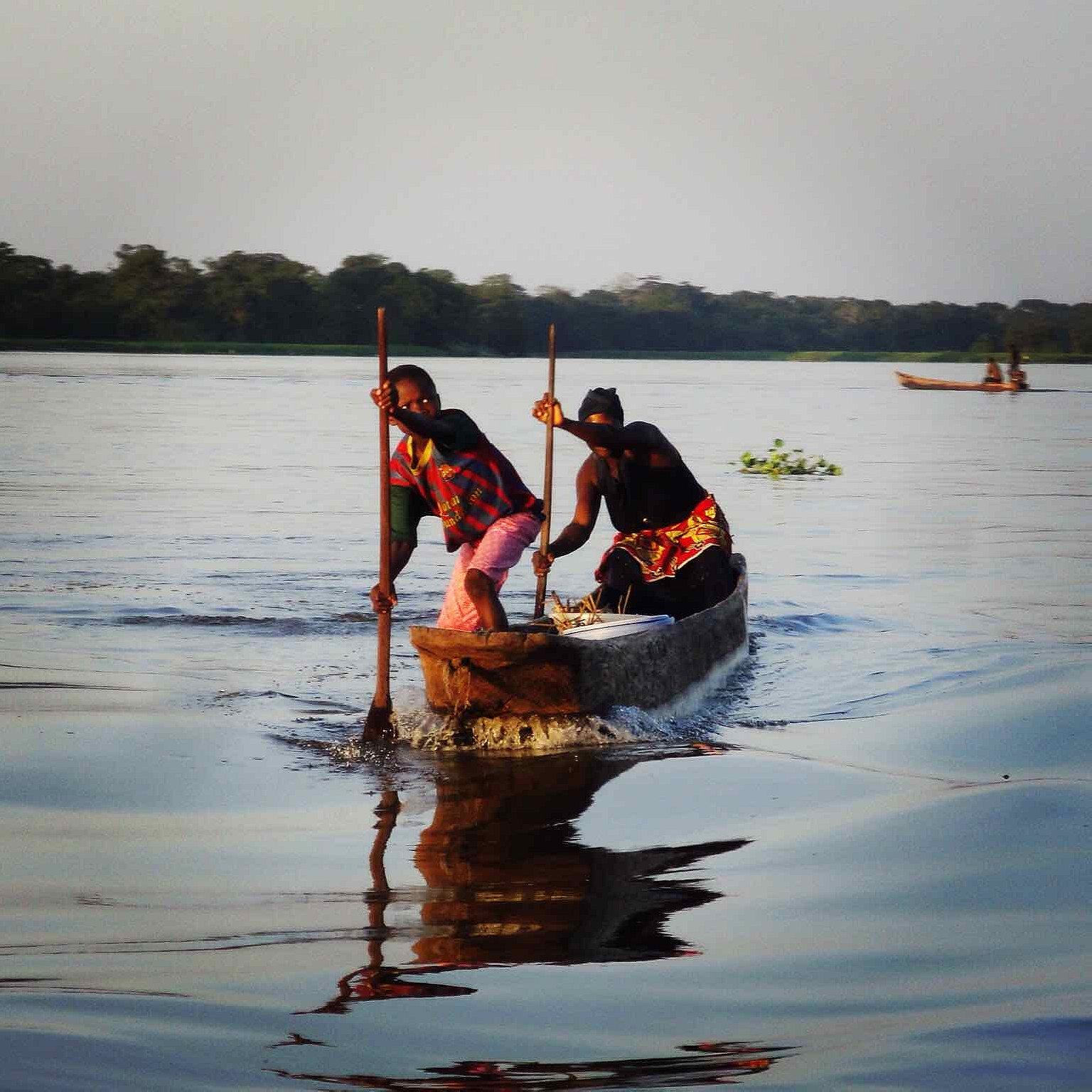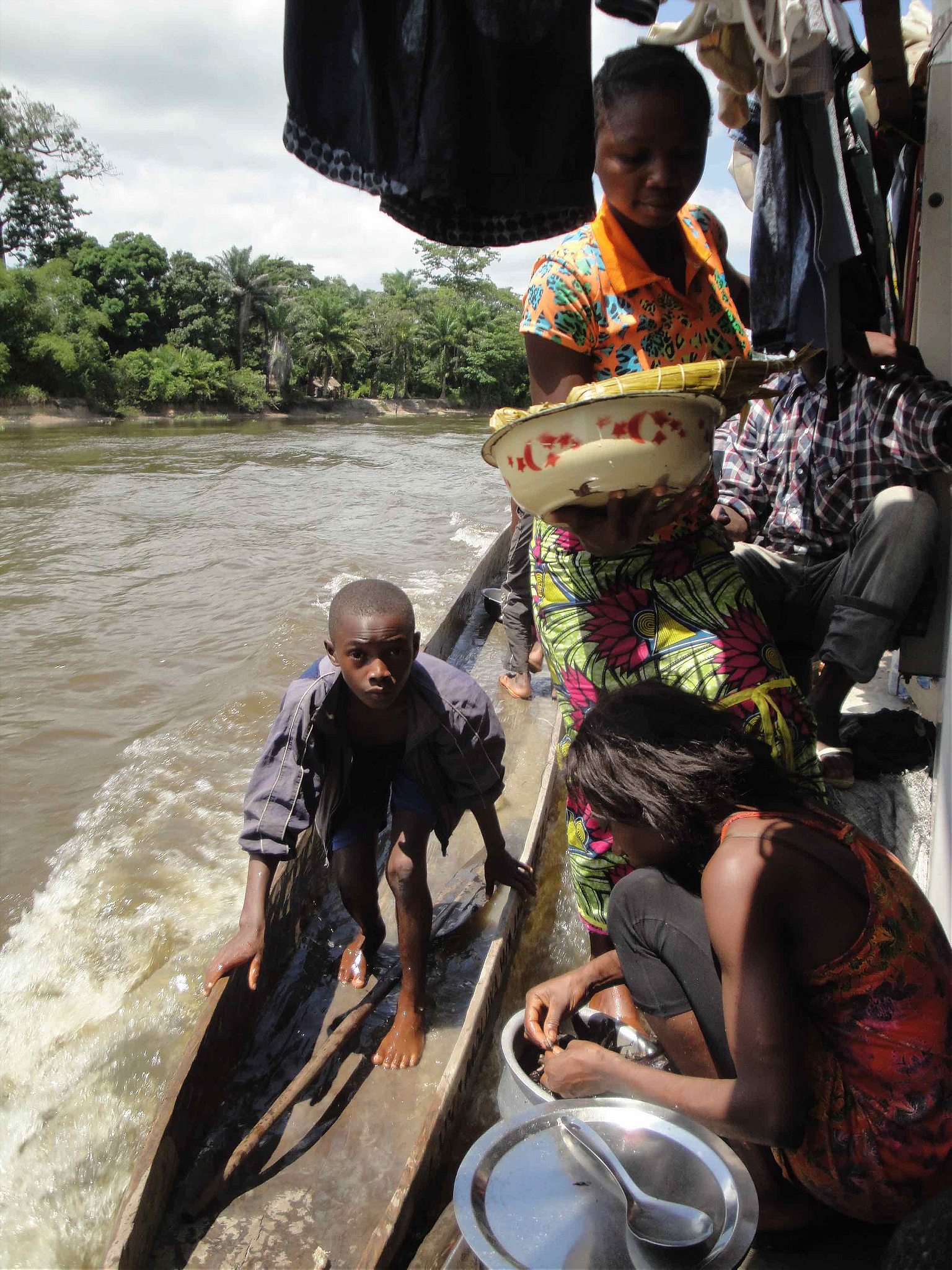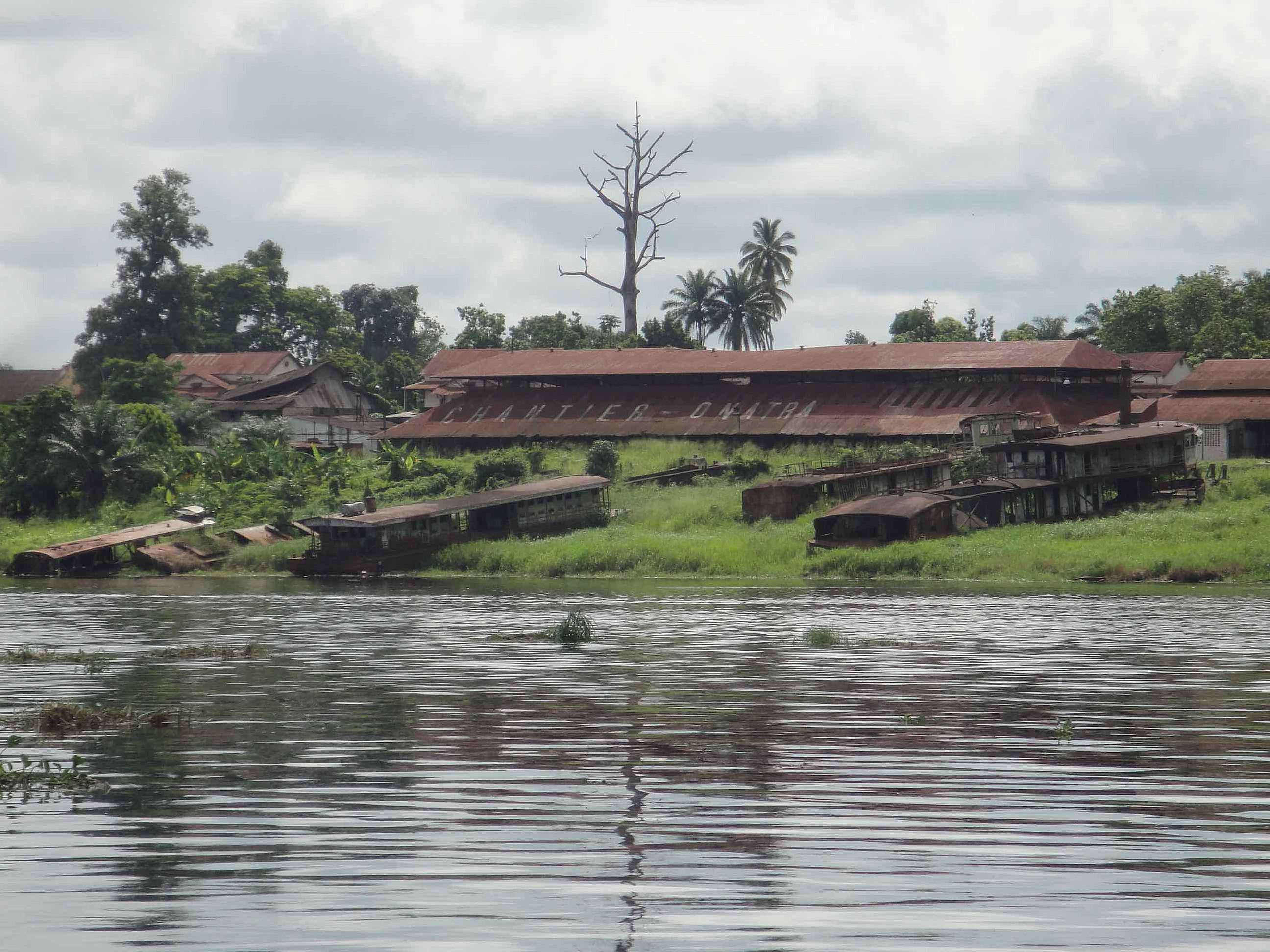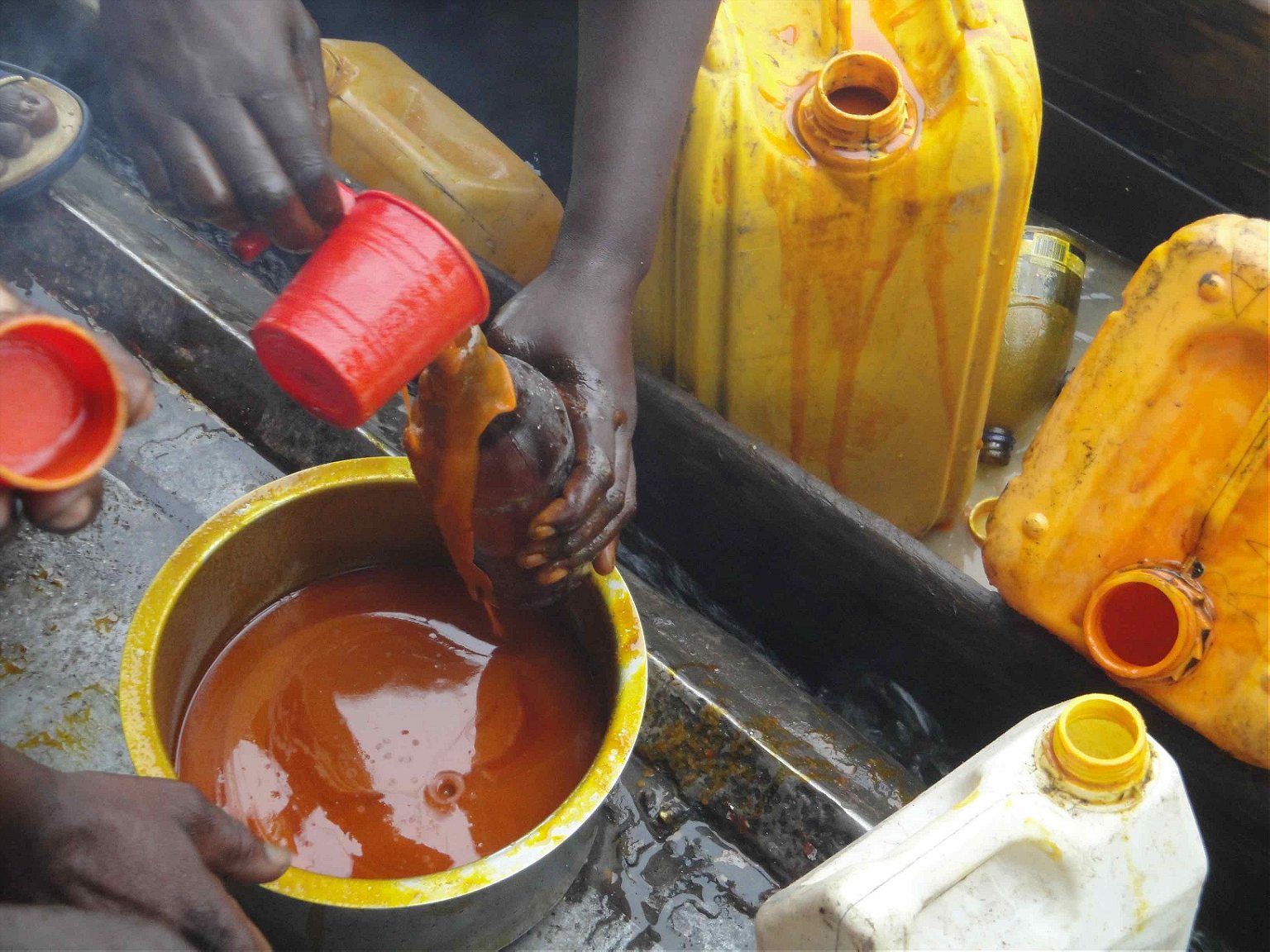In a country with crumbling infrastructure, cargo barges are vital for ferrying goods and unofficial passengers along the Democratic Republic of Congo’s aquatic superhighway.
ON THE CONGO RIVER, Democratic Republic of Congo—
It begins with shouting. Almost everything here seems to. This time they are shouts of encouragement: “Vite! Vite!”—“Faster! Faster!” But the teenage girl in the pirogue, a type of dugout canoe, is unable to pull alongside the barge, which is making its way down the Congo River at a speed of about 10 miles per hour. The girl, who lives in a village somewhere beyond the impenetrable wall of jungle that lines both banks of the river, is trying to collect her brother, who boarded the barge two days ago when it left from Kisangani on its 1,000-mile journey toward Kinshasa, the sprawling capital of the DRC.
The barge won’t slow down. It will stop only on the orders of the captain or Mother Nature, such as when it grinds to a halt on one of the many sandbanks that dot the river. It certainly won’t stop for a passenger. This is a cargo boat, after all, not a ferry. Printed in faded red paint on one of the containers that sit atop the 170-foot long, 40-foot-wide barge are the words “Passengers prohibited.” Perhaps the faded paint is emblematic of the authority of the text: I am one of more than 200 passengers on board.
It becomes clear that the young girl will not be able to catch up, however furiously she paddles. The realization slowly shows on her face. A slight, flickering smile, and a tiny shrug of the shoulders. The shouts turn into cheers. The other passengers know what’s coming, but I don’t. Her brother, clutching his plastic carrier bag of possessions, takes the only option left: He jumps from the moving barge feet-first into the river, holding the bag high above his head. A few seconds later, his sister paddles up to him. He clambers into the pirogue and turns to wave. The passengers on the barge cheer and wave back.
Welcome to life on a Congo River cargo barge.
To call them simply cargo barges doesn’t paint the full picture. They are usually owned by wholesale companies operating in the DRC, and they do indeed carry cargo. The metal barges are pushed by what is essentially a tugboat. Sometimes the barges number as many as five, each more than 100 feet long, fastened together lengthways. From Kinshasa, they transport imported materials, household goods, used vehicles, secondhand clothing, and canned foods to the towns that line the banks of the river: Mbandaka, Lisala, Bumba, and Kisangani. On the return leg, they ferry beans, smoked fish, timber, palm oil, flour from the cassava plant (to make the staple food of foufou), and charcoal to the capital. Not all the cargo belongs to the company, especially on downstream journeys. Senior members of the crew will often supplement their income by purchasing charcoal and smoked fish to sell in Kinshasa, or they will sell cassava flour to villagers along the river in areas where the plant is unable to grow.
A handful of passengers transport goods, too. Mama Esther is one of them. Nobody uses her actual name. “Esther” refers to the name of her baby. “Mama” is often used as a form of address when speaking to Congolese women who are (or are presumed to be because of their age) mothers. Likewise, men who have reached middle age are frequently addressed as “Papa,” like the captain of the boat, Papa Jean.

Mama Esther is 19 years old. She has paid to transport 26 sacks of beans downstream from Kisangani. When Mama Esther reaches a town where buyers meet her asking price, she’ll disembark and wait for the next barge traveling in the opposite direction to return home.
She asks me what kind of salary she might earn if she worked as a waitress in London. I’m reluctant to tell her, the figure sounds so ridiculous. She laughs and shakes her head at my answer. “We are too poor here. Life is too hard.” She points across the river to three people standing on a crude 10-by-8-foot raft of bamboo and palm leaves, with a thatch tent covered with blue plastic sheeting perched on top. “Look,” she says, “they have no money to even travel on this boat. So they build that and float down the river.”
The majority of the passengers on the barge have paid to be taken all the way to Kinshasa. Only a few of them are transporting goods like Mama Esther is. Most are looking for work. Some are visiting family, something that may well have an economic element to it: It is a common expectation in the DRC and surrounding countries that when someone arrives in a new city, family members and even very distant relatives will offer support in the form of food and shelter, and perhaps even help with finding employment. And one passenger is a tourist. The travelers on board laugh when I tell them I’ve taken this 16-day trip “to see the river.” Although my skin color reflects the fact that one of my parents is African, I am addressed and referred to as “mundele” (which means “white man” in Lingala, the major language in the DRC).

The DRC has roughly the number of road miles as Belgium, its former colonial ruler, but it is 75 times larger geographically. Most of these roads are unpaved and in atrocious condition. Many goods are transported by air by those who can afford it. But for the vast majority, who do not have the money, and for goods that can be transported between two points on the same river, river transport is the most viable—and sometimes only—option.
There are no passenger boats in this country, except for those that ferry people between Kinshasa and Brazzaville, the capital of the Republic of Congo, the neighboring country, which sits on the opposite bank of the river. The DRC has 18 major rivers, with dozens more tributaries that constitute rivers in themselves. But when referring to the largest one of all, the Congo River, Congolese simply say “Le Fleuve” (“The River”).
It is a rare constant in a country of upheaval, surrounded by the mismanagement, corruption, and civil war that seem endemic to Congo’s recent history. It flows past derelict warehouses and abandoned steamboats once used by the Belgian colonial regime. The rust-ridden steamboats line the riverbank like metallic graves in an overgrown cemetery, engulfed by tropical vegetation.
When the barges dock to unload their goods, decrepit cranes loom idly overhead as everything is carried on the shoulders of young men gleaming with sweat. It is a scene from a time before the shipping container was invented. The infrastructure is crumbling, few people have a good word to say of the government in Kinshasa, and the world’s largest U.N. peacekeeping force is operating, with controversies of its own, in the east of the country. But Le Fleuve and the life it sustains continue as always.
It is a life that feels unique to these barges. The passengers are packed into all available space so tightly that some people can barely sit down. The equatorial sun, the heat from dozens of rudimentary charcoal stoves used to grill maize and boil cassava—the staple foods on the boat—create an inferno of heat. At times I find the combination of this and the incessant shouting almost torturous. The slight breeze from the barge’s movement down the river is a godsend. Some people have plastic sheeting, which they tie overhead to act as a shelter from the sun. A plastic cup or two is used to scoop up river water and passed around to quench thirst.

A daily routine forms. The barge stops each night, usually near a small clearing on one of the riverbanks. Sometimes there are a few inhabited thatch huts in the clearing. Papa Jean says many boats travel through the night, but this boat is on schedule and so they can afford to take their time. The male passengers (and those women who are traveling with their husbands) disembark and sleep under the stars. Unaccompanied women usually sleep on the boat. Few have mosquito nets. Their bed is a plastic sheet.
There is no toilet on the barge, and just one squat toilet that doubles as a shower (with a bucket of river water) in the tug. The majority of passengers don’t use it and simply relieve themselves off the side of the barge or wait until they are able to disembark in the evening.
I sleep on the sacks of beans in the hold. There are fewer mosquitoes down here than outside, but probably a similar number of rats. One morning I am so annoyed by having a rat run across me every 20 minutes that I clamber out of the hold, step over the sleeping bodies on the floor, and sit on an upturned charcoal stove, staring out into the darkness where the river is. It’s 4 a.m. People begin to wake up an hour later and discover me sitting here. They ask with worried expressions whether I am unwell. When they learn the actual reason, they find my discomfort hilarious and news quickly spreads around the boat.
The passengers sleeping on the riverbank are woken up an hour before sunrise. They roll up their mats and make their way on board to the spot they had occupied the day before. The boat is usually moving before the sun is up. Morning prayers are sung, and teeth are brushed. The Congolese, at least the ones on this boat, seem to brush their teeth with a religious zeal. Everyone owns a toothbrush, and their vigorous brushing usually lasts no less than five minutes. In the first half-hour after the barge starts moving, white foamy patterns of toothpaste shoot past in the calm waters next to the barge, sometimes in streaks, sometimes in circles, sometimes in a series of dots, like a peculiar slideshow of abstract art.

By this time, Henriette, a generously sized twentysomething clothed in colorful wax print fabrics, has already started her two charcoal stoves, which she uses to make benye (the words for doughnuts in eastern DRC Swahili). Henriette is quite a character on the boat, with her shouting, joking, and jovial teasing of one of the members of the crew.
She sleeps on the barge, in the same place she occupies during the day, on the left side next to the water. She made an almighty fuss to get this spot when she boarded in Kisangani. There was a lot of shouting. People refer to her as “Big Girl” behind her back. Whispering does not seem to be a Congolese forte, so she has been heard shouting, “My name is not ‘Big Girl!’ ” a number of times already.
“This is the best place,” she explains. “I am close to the water, there is space to cook, and it is easy for people to buy from me here.” A constant stream of customers edge toward her, often balancing precariously on the outer edge of the barge. They leave with plastic bags full of steaming doughnuts to share with some of their fellow passengers. By the end of the journey, I am probably her best customer.
Henriette is not the only entrepreneur catering to the passengers. Soon after the sun rises, the pirogues begin to appear. Their appearance is usually accompanied by raised voices. The people in the pirogues argue over how to pull up alongside the barge. The people on the barge shout for the pirogues to stop close to them. Because the barge is so crowded, it’s very difficult to move quickly from one spot to another; people closest to where the pirogues stop have first refusal on whatever is being sold.

Papa Jean, the captain, sits in his plastic chair at the rear of the barge with his back facing the direction of travel. On his immediate left is the river. To his right, cluttered with plastic buckets, wooden mortars for pounding foufou, and sacks of charcoal, a passage leads between an engine and a container toward the hatch to the hold of the barge. In front of him is a chest freezer powered by the onboard generator.
When a villager pulls up in his pirogue and offers a freshly caught fish that catches his eye, Papa Jean will inspect it, argue loudly over the price of it, eventually buy it, and finally fling it straight into the freezer, still alive. “Perhaps I will sell some of the fish, it depends how many I have when we arrive. Generally I buy them for my wife,” who lives in Kinshasa, he says. He usually has first refusal on the most valuable fish because the space in front of him, which is about 8 by 4 feet, is one of the more convenient places for the pirogues to stop.
As I ask him about how long he has worked on the river, three pirogues come into view. As they get closer, and the waves created by the barge become higher, one of the pirogues begins to fill with water from the front nose. One of the three women in the canoe uses her wooden paddle to push the water out. The woman in the middle skips deftly backward to rebalance the weight of the pirogue, while the third one changes the canoe’s angle to the waves. They manage to pull alongside the barge with a few inches of water in their boat but everything intact.

One of the pirogues behind them is not so fortunate. Despite the frantic bailing of water, they are unable to avoid the slow nosedive into the murky waters. In a surreal way, it feels almost like watching a television game show rather than the routine trading of goods. The villagers in the rapidly sinking canoe point at the three women who managed to make it to the barge and smile while shaking their heads in what seems to be a gesture of feigned disbelief. The three women laugh loudly. The passengers on the barge watching the entire spectacle laugh and even cheer.
The space in front of Papa Jean is shared by two members of the crew and five passengers, including myself. There is always at least one charcoal stove burning, often with a pot of boiling river water balanced precariously on top, about knee-high. The villagers tie their pirogues to the barge and step over the stoves and the pots of boiling water carrying their goods: bamboo cases of smoked fish; freshly caught fish of varying sizes hooked together on a piece of wire or placed in a plastic washing bowl; a woven basket full of avocados; smoked bush meat; grubs covered in dry grass; and bunches of bananas.
Nobody offers me their wares. I must call them over. The most attention I receive is a quick glance and then a chuckle. One woman clambers out of her pirogue, looks up and sees me eating foufou, rocks back with laughter while clutching her belly and almost falls into the water. “Mundele!” she exclaims. “He’s eating foufou!” She bursts into laughter again. I hope nobody tells her about the rats.
Top image: A village on the bank of the Congo River. Photo by: Samuel Middleton.
